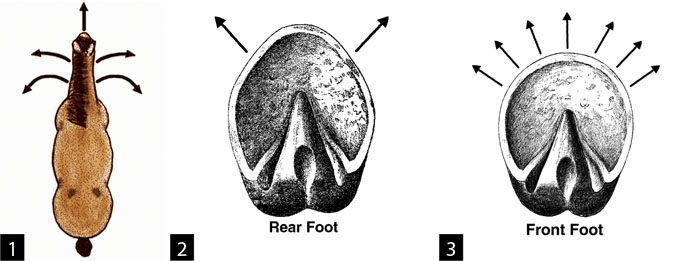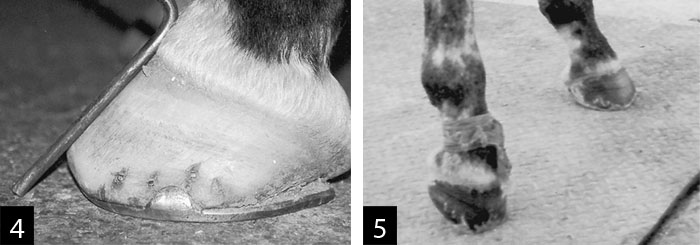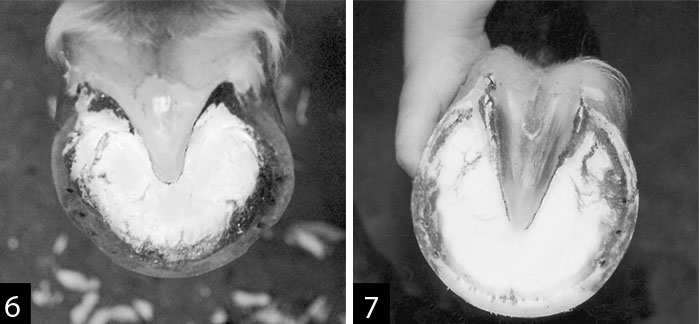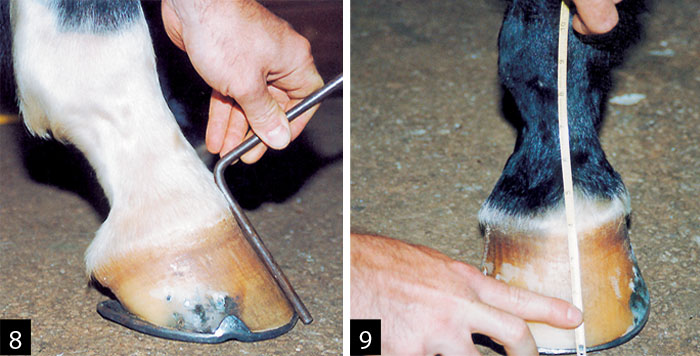By Lynn Jean, CJF
While the next five opening paragraphs were written by a leading British veterinarian in 1895, the ideas still hold true today when it comes to shoeing horses.
“Farriery is the art of shoeing horses and can only be properly learned by a practical experience in the shoeing forge. If the foot of the horse were not a a living object, perhaps the training obtained in the forge would be all that was necessary for efficient workmanship.
“As, however, the hoof is constantly growing, it is changing in form. The duty of the farrier therefore is not merely to fix a shoe upon the hoof, but to reduce the hoof to proper proportions before doing so.
“Now, as the hoof is only the outer covering of a sensitive foot, damage to the exterior surface may injure the structures within. Injury does frequently result, and not always from carelessness. Perhaps as much injury follows careful work based on wrong principles, as slovenly work carried out in perfect ignorance of any principle.
“The injury to feet resulting from shoeing may not be apparent at once. It may be, and often is, of a slow and gradual nature, and not credited to its true cause until the horse is rendered an incurable cripple.
“It seems evident then that to do justice to a horse, a farrier should not only possess manipulative skill, but should have a correct idea of the structures, functions and variations of the hoof.”
This statement was written by William Hunting in his 1895 book entitled The Art Of Horse-Shoeing.

FIGURE 1. The horse’s movement is in a straight line or an arc. FIGURE 2. The hind foot gives the horse’s amovement guidance and direction. FIGURE 3. The front foot can break over easily at any point of the toe, making it easy for the horse to move in any forward direction.
Biomechanics Questions
Have you ever asked yourself these questions taken from this book?
- During forward movement, how many different directions can a horse travel?
- What is regarded as the normal conformational stance of a horse?
- Why is the front foot almost round?
- Why does the rear foot have a corner or point to the toe?
- What is the main function of the front limbs?
- What is the main function of the rear limbs?
- Does the length of pastern have any association with the length of toe?
- Does the size and weight of the horse have any bearing on the size of the foot?
- Can we compare the equine athlete to the human athlete?
- What analogies can we link to each?
Critical Answers
During 30 years of serving the horse, I’ve learned to question myself from time to time.
When I view a horse moving forward, I have come to realize that the horse moves in only two directions. There is the straight line and the arc, which varies to either side and in degree, but still is an arc.
Looking at the skeletal structure of the horse, 80 percent of the horses I see are slightly toed out in front and behind. The foot, knee and forearm of the leg line up and under the mass of the front end. The rear foot is pointed outward from the line of the spine some 10 to 12 degrees. However, this conformation tends to line the hocks up under the gluteus muscles of the hip.
The front foot’s appearance resembles a horizontal bearing. Larger and rounder than the rear foot, this shape allows it to bear the weight and breakover with equal ease at any point on the toe.
The rear foot has a corner or point that has a dual purpose. First, it gives guidance and directionally influences the leg. Second, it gives the limb something to dig into the ground with, providing resistance to change energy into forward motion.

FIGURE 4. Does this severely trimmed toe actually help or hurt the horse? FIGURE 5. It was difficult to replace this horse’s right front shoe because he could barely balance on his nonexistent rear toes.
As the horse moves in a straight line, both hind feet push and breakover only occurs after the whole leg including the hock is in front of the foot. When the horse travels straight, breakover occurs at the medial toe quarter. When the horse is moving in an arc, the inside leg’s foot breaks over at the lateral toe quarter while the outside leg’s foot is still breaking over the medial toe. These actions allow the maximum amount of ground to be covered with the least effort.
The front limbs serve a tremendous responsibility, as they keep the horse’s nose from hitting the ground. Some 90 percent of their function is vertical lift and 10 percent is for guidance during arcs.
Rear Legs Are Different
Because the center of mass is always in front of the rear legs, they are responsible for propulsion.
The length of pastern varies from horse to horse; therefore, to keep the complex lower leg anatomy working properly, the toe length must be as close to the length of the pastern as possible.
The size and weight of the horse are the main factors that determine the size of the foot. Is there adequate hoof surface area to bear the weight of the horse?
I believe the horse and human as athletes are very similar. Both can accomplish extraordinary feats with proper nutrition, conditioning and training. They can both fail if any part of these elements is missing.
When viewing the human in a “starting block” sprinter’s stance, the body strongly resembles the horse. The arms become the forelegs, the chest becomes the barrel and the hips are the hips. The human knee becomes the stifle, the raised heel becomes the hock and the toe becomes the pastern.

FIGURE 6. Pared hind foot. FIGURE 7. Trimmed front foot of the same horse.
One analogy I like to use is the person pushing a full wheelbarrow. This is a good example of what a horse feels. The wheel is responsible for keeping the cargo aloft. The wheel serves as the forelegs, the cargo is the mass and the center of mass is above and behind the wheel. The wheelbarrow handles function as the loins. The handles intersect the person at the hips forming the “universal joint” that is used when the horse changes direction of movement from a straight line to an arc.
Now let’s complicate things and add an incline. What part of our anatomy do we really depend on now?
Conclusions
Most horses are asked to do the same thing—move forward. If I utilize the roundness of the front foot for ease of direction, straight or in an arc and cover the foot with an adequate shoe, the flexors are responsible for achieving the lift that is necessary. The rear feet can now perform their task of forward push. All parts of the foot are necessary to facilitate this purpose, especially the toe.
Shortening the surface area of the foot with excessive trimming or applying a blunted or square-toe shoe takes away too much energy and function from the foot. The horse has to work harder to cover the same amount of ground. It would be the same as installing lawn mower tires on your shoeing truck! I try to set my horses up with a hoof length that closely resembles the length of the pastern.
For example, I shoe a Thoroughbred and Warmblood cross that’s 17 years old, 16.3 hands high and weighs 1,300 pounds. The front pastern length is 4 7/8 inches and the rear pasterns are 5 1/8 inches long. The length of the front foot after trimming is 4 1/2 inches and the rear foot length is 4 3/4 inches.
Both front and rear feet are fit full or “perimeter fit” with plenty of expansion and the heel length is at least directly under the bulbs. This horse participates in four or five 3-day events per year. He is sound, takes training well and is like shoeing a statute. He is not sore in his hocks, stifles, back or shoulders.
This was not the case a few years ago. His feet were nearly destroyed as he was wearing short size 2 shoes on severely squared toes with no room for expansion. He was sore all over, had an unpleasant attitude and it took at least 3 hours to shoe him.
Making a horse’s hoof smaller than normal by trimming or squaring the toe only impairs the function of the foot and the horse as a whole.

FIGURE 8. The proper length and angle of toe for soundness. FIGURE 9. Notice the length of toe compared to the length of pastern.
It’s unfortunate that the horse had been subjected to the “short” style of shoeing. Many remodeled feet, shortened hooves, blocked and square toes with inadequate expansion have led to a short life expectancy for a truly tough animal.
Unfortunately, the “authority figures” involved, including vets, shoers and nationally known trainers, seem to accept these conditions as normal and sometimes even necessary!
Question yourself and others from time to time. Get into the habit of researching your answers from as many sources as you can and make up your own mind. Don’t shoe a certain way just because everybody says it’s right.
Toe Mechanics
Taking away the toes hurts the horse more than it helps.
By Randy Luikart, CJF
In recent years, there has been an abundance of published information on the length of toe affecting normal function of the horse’s limb. In the November, 1999, issue of American Farriers Journal, “Strategies For Overcoming Long-Toe, Underrun Heel Concerns” concluded that long toes caused low heels.
The May, 2000, issue of The Horse contained an article on the four-point trim, which inferred that long toes cause dished feet.
We must be terribly naive to believe that both of these foot problems, which are extremely different in appearance and hoof mechanics, are caused by excessive toe length.
We’ve been led to believe that “natural” must mean an improvement over past methods of trimming. We’ve also been told that squaring, rocking, rolling or “setting back” the toe improves the horse’s mechanics and hoof function. Easing the breakover must make it easier for the horse to move.
Or does it? What is the difference between the functions of the toe and heels? How do these hoof parts provide different applications of mechanics for the front and hind leg? Do we understand form and function? Maybe not.
Front Vs. Hind Limb Function
The difference between the workload of front and hind limbs is the most confusing concept. Quite simply, the front legs provide the majority of lift for the body (vertical acceleration) and a small percentage of horizontal acceleration, while the hind legs provide the majority of horizontal acceleration and a small amount of lift.
We have heard and read for years that since the center of mass of the horse is behind the front legs, we must provide posterior support for the front limb. This is provided by length of shoe, egg bar shoes, removal of hoof at the heel to locate the buttress of the hoof or heel of the shoe further under the cannon bone.
These treatments are all mechanically good ideas that will support the body during load acceptance (the first part of the weight-bearing phase). They also give support during the lifting of the body in part of the load application (propulsion) phase.
Conversely, the center of mass is in front of the hind limb. During the load acceptance portion of the weight-bearing phase, the hoof is in front of the hip and is loading on the posterior side (heels). During the propulsion phase (load application) of weight bearing, the hoof is behind the hip and the toe is loaded.
In the standing horse, this mechanical difference is significant in that if you could saw the horse in half through the center of its mass, the front half would fall backwards and the back half would fall forward. When standing, the weight of the horse is borne on the heels of the front feet and on the toes of the hind feet.
To appreciate the sensation for these mechanics, stand up straight, plant your feet squarely under your body and lean backwards. It’s impossible, because there is no support for your center of mass that’s moving behind your support. If your shoes were lengthened and nailed to your feet, then you could lean backwards.
Stand comfortably again with your toes pointing straight forward, heels on the ground and lean your body forwards. Feel how the stress is applied to the back of your leg.
Lift your heels (your heel is approximating the horse’s hock) off the ground until you feel the weight pass from the back of your leg into the front part and toes of your foot.
This is how a horse stands all the time. The horse’s hind toe provides support for the body mass while standing, just as the heels provide support for the front limbs.
Shoeing Front, Hind Feet
Shortening the heels of the front shoe will not enhance the front leg’s mechanical function and will most likely inhibit it. Logically, setting back or squaring the shoe behind the edge of the foot or otherwise altering the hind foot’s ability to support the body would not promote better mechanical function.
This is true for the horse whether he is standing or propelling himself forward. Systematically squaring, rocking or setting back the hind toes does not allow the horse to apply force to the ground correctly for standing or movement.
Unfortunately, a tremendous number of farriers practice these techniques on the hind feet. Reducing the hind toe’s ability to support the body for standing or horizontal movement requires the front legs to provide more horizontal propulsion than they should.
This additional mechanical load on the front limbs requires the horse to pull himself forward, thus requiring more mechanical exertion by increased force to the ground or increased contact with the ground.
This begins a sequence of events that leads to gait and/or shoeing problems, which will eventually overload the front limbs and may cause lameness.
Toe Length, Sole Type
We must consider the importance of the correct length and fit of the toes. Horses have minimum requirements for hoof base (both toe and heel for support and propulsion), toe length, frog support, toe angle and sole depth. In defining minimum and maximum lengths for any foot, you must consider the wall length required to adequately cup the sole.
This hoof wall length and sole cup relationship provides the support that the internal structures of the hoof require during weight bearing. A flat-soled horse does not have enough wall to cup the sole. The depth of the cupped sole must also be adequate to provide protection from terrain damage to a soft, overtrimmed sole or the coffin bone.
The shape of the cup and length of hoof wall is required for the horse to dig into the ground for horizontal acceleration. A hoof angle that provides hoof and pastern alignment is mandatory, and frog support is necessary for adequate hoof function.
The hoof and shoe base provides support for the bony column and its applied mechanics. The base provides support for the body to accept load or apply load during movement and standing. Failure of the horse to accept a load correctly (for example, rocking back) or apply load properly (slipping) will result in inefficient application of force and movement.
The hoof and shoe base combined with a proper toe length allows the deep digital flexor apparatus to provide the propulsion needed to move the horse’s center of mass. This means that the horse picks up its foot when it is done applying force to the toe.
Premature breakover before the leg has finished applying force to the ground causes excessive shoe wear at the toe. It causes the horse to apply more force to the limb on the next step to maintain acceleration.
Many factors contribute to proper limb function, including toe length, sole cup, sole depth, frog support, adequate heel and toe support correlated with body weight, foot base size, shape and proper positioning under the leg. Systematic removal of toe wall without consideration of hoof and limb mechanics or body mass is not in the horse’s best interest.
Individual Variation
Consideration of these mechanics brings us to the conclusion that larger horses with higher work loads require a greater hoof surface area. These horses have greater mass to move and require more traction and surface area to accomplish the mechanical task.
Horses with longer pasterns have a higher load acceptance than a horse of equal weight and shorter pasterns. Therefore, they will need a higher load application (propulsion) to remain in mechanical balance. Any toe modification of the shoe or hoof that reduces these mechanics below the minimum necessary for proper function will make the horse less efficient in force application to the ground, which enables movement.
We have long understood the concept that the heel of the front foot provides limb and body support for weight bearing and load acceptance. As farriers we must understand that the horse’s hoof and limb mechanics provide vertical propulsion through the heels while accomplishing horizontal propulsion with the toes.
Anything less than the most efficient foot possible is unacceptable to the horse and unethical for our shoeing profession.







Post a comment
Report Abusive Comment